Lists of Early Florentine Cardmakers (- 1460)
composed by Lothar Teikemeier, last updated 06.12.2012
|
Documents in Ferrara (about imports from Florence)
(Source 01)
- unknown cardmaker (1423) (8 very expensive Imperatori cards)
- Ser Ristoro e compagni (1434 - "sette fiorini d’oro" for 2 decks)
Zdekauer note
(Source 02)
- (1427) Antonio di Luca. Makes naibi. 42 years old, born in 1385.
- (1430) Antonio di Giovanni di Ser Francesco, naibmaker. 33 years old. Born in 1397. It says: Find of me (?) so many printing plates for cards and saints, and other things necessary for my profession<.
- (1446). Jacopo di Poggino, card painter. 48 years old. Born in 1398. (special article)
Jacobsen list (finishing years are last sign of activity)
(Source 03)
- Baldo di Piero di Antonio di Baldo (1425->1458)
- Donnino di Giovanni di Francesco (1370->1447)
- Filippo di Marco di Simone (1435->1458) (special article)
- Francesco di Gabriello di Nuccio
- Francesco di Piero (c1360->1410)
- Franco di Piero (1364->1433)
- Giovanni di Donnino di Giovanni (1405->1433)
- Giovanni di Franco di Piero (1426-1448)
- Iacopo di Poggino di Luca «Paparello» (1398-1481) (special article)
- Piero di Donnino di Giovanni (1413->1447)
Silk dealer (acquire lists - 1431-1460)
(Source 04)
---- intensive activities by:
- Antonio di Dino (Trionfi decks) (special article)
- Niccolò di Calvello (special article)
- Antonio di Simone (special article)
- Matteo Ballerini (Trionfi decks) (special article)
- Giovanni di Domenico (Trionfi decks) (special article)
- Manetto d'Agnolo merciai (supplier - Trionfi decks) (special article)
---- much less intensive activities by:
- Grosso (1432)(4 actions)
- Luigi rivenditore (1432)(6)
- uno fanciullo (1432) (3)
- Simone di Ser Antonio Fazi (1437) (4 decks for 20 Soldi)
- Antonio Trinchaglia[?] (1442 + 1453) (6)
- Meo di Ghoro (1442) (7)
- Foci(?) merciaio (1442) (1)
- Francesco (1443) (1)
- Una donna (1443) (1)
- Giusto di Giovanni dipintore (1443) (1)
- Francesco che fa i naibi (1443) (1)
- Christofono di Meo di Francesco fa i naibi (1445) (1)
- uno fanciullo (1449) (1)
- uno dipintore (1452) (1) (12 Trionfi decks)
- Antonio vochate il Chico(?) dipintore (1452) (1) (13 Trionfi decks)
- Antonio dipintore tra forzenai (1453) (1) (12 Trionfi decks)
- Francescho dipintore (1453) (1)
- Francescho di Nicholo dipintore (1453) (1)
- Cetina(?) fa i naibi (1453) (1) (12 Trionfi decks)
- uno dipintore (1455) (1) (12 Trionfi decks)
Silk dealer (sale list 1439-1455)
(Source 05)
Lapini family (1415-1422 + 1453-1455)
(Source 06)
- Antonio (?) (1415) (6) (cheap decks)
- Antonio di Francesco (1415) (4) (cheap decks ?)
- Piero di Antonio (1415-1418) (21) (7 decks for 20 Soldi)
- Antonio di Dino (1453-1454) (4) (Trionfi) (special article)
- de la Lisa(?) (supplier) (1453) (1)
- Pagholo Corsellini merciaio (supplier)(1454)(1)
Puri family (1447-1449)
(Source 07)
Bartolomeo di Paholo Seragli and business of Filippo di Marco
(Source 08)
Double Appearances
- Jacopo di Poggino (Zdekauer) = Iacopo di Poggino di Luca «Paparello» (1398-1481) (Jacobsen list) = Paparello (Lapini and silk dealer sales)
- Filippo di Marco di Simone (1435->1458) (Jacobsen) = Filippo di Marco (Seragli list)
- Francesco di Piero (c1360->1410)(Jacobsen) possibly = Franco di Piero (1364->1433) (also Jacobsen)
- Antonio di Dino (at silk dealer acquire list and silk dealer sales list and Lapini list), possibly identical to "Antonio" (silk dealer acquire list)
- Antonio di Simone appears at silk dealer acquire list and silk dealer sales list.
- Matteo Ballerini appears at silk dealer acquire list and silk dealer sales list. Franco Pratesi comments: "Matteo is indicated in a rather confusing way, more often as Matteo di Bartolomeo or Matteo Ballerini. These names could already correspond to two different makers, and further ones might be present when we find Francesco as father’s name. I am nevertheless fully persuaded that we are in the presence of a single maker, variously mentioned, even if we are not accustomed to find anyone indicated as son either of Francesco or of Bartolomeo."
- Giovanni di Domenico appears at silk dealer acquire list and at the Seragli list.
- Francesco (active 1443) might be "Francesco che fa i naibi" (active 1443) at the silk dealer acquire list.
- Francescho dipintore (active 1453) might be "Francescho di Nicholo dipintore" (active 1453) at the silk dealer acquire list.
- Antonio vochate il Chico (?) dipintore (active 1452) might be Antonio dipintore tra forzenai (active 1453) at the silk dealer acquire list.
- "Uno fanciullo" (4x), "uno dipintore" (4x), "una donna" (1x) (all at silk dealer acquire list) naturally offer not much possibilities for an identification.
Assumed Relationships
- Giovanni di Franco di Piero (1426-1448) is possibly son of Francesco di Piero (c1360->1410), who is possibly = Franco di Piero (1364->1433). Giovanni di Donnino di Giovanni and Piero di Donnino di Giovanni should be sons of Donnino di Giovanni di Francesco (all at the Jacobsen list)
- Antonio di Simone (silk dealer lists) might be the son of Simone di Ser Antonio Fazi (Ferrara list)
|
|
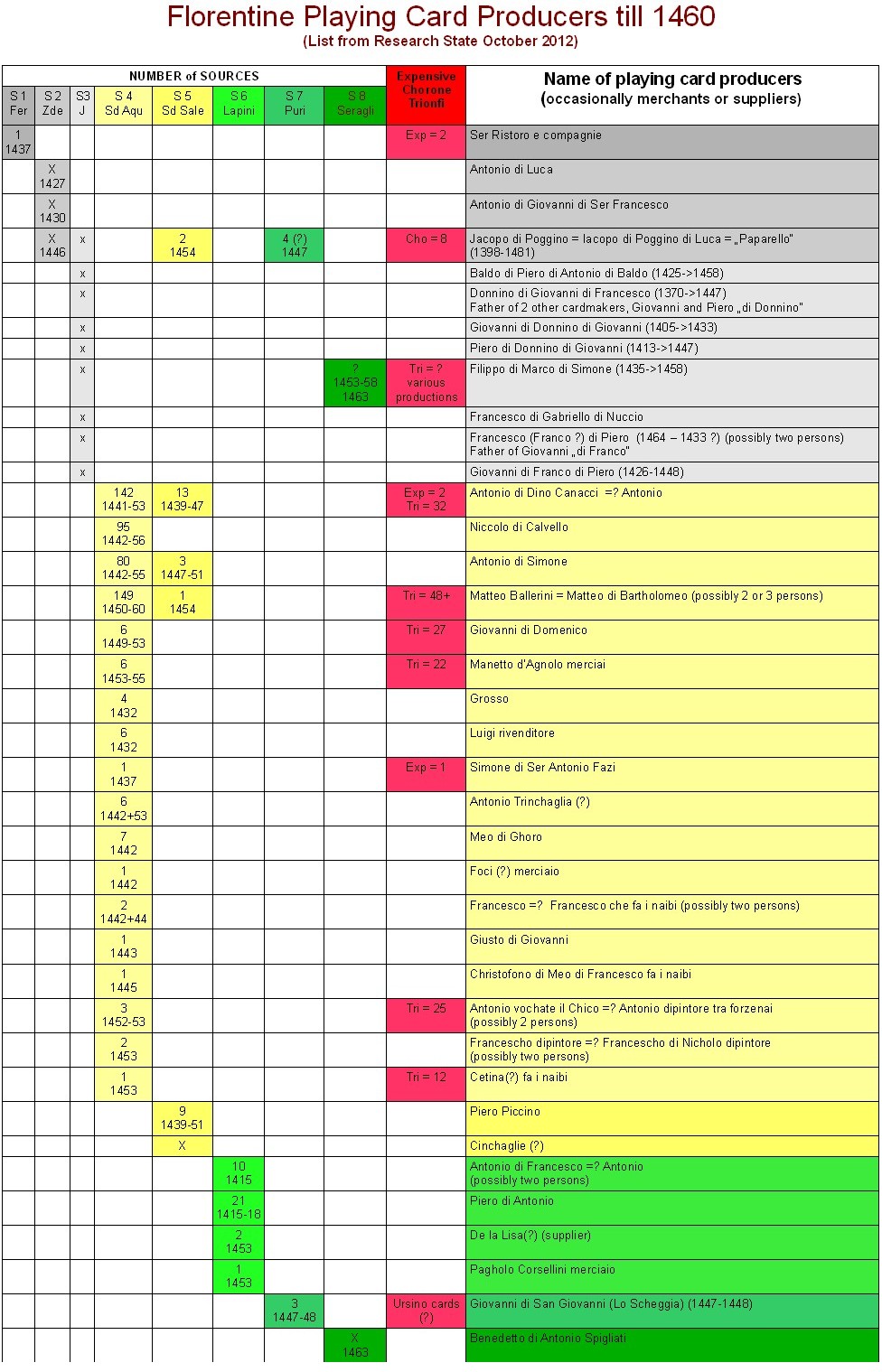
Explanations to the list
- Fer = Ferrarese Sources
- Zde = Zdekauer Note
- J = Jacobsen List
- Sd Acq = List "Silk dealer acquire decks"
- Sd Sale = List "Silk dealer sell decks"
- Lapini = Lapini family activities
- Puri = Puri family activity
- Seragli = Bartolomeo Seragli and Filippo di Marco activities
- Single entries present the number of recorded activities of an artist (upper line) and the time range of the activities(lower line)
- Red cells: The expressions Exp (expensive decks for 20 Soldi or more), Cho (decks called "Chorone", which are also relative expensive) and Tri (Trionfi decks) indicate the number of produced decks by the related artist.
- Involved artists or suppliers, which are addressed only as "uno dipintore", "uno fanciullo" or "una donna" are not part of the list. In one case "uno dipintore" sold 12 Trionfi decks to the silk dealer.
Sources
Sources are mainly taken from Franco Pratesi's new article series written from November 2011 till now, published
here at Trionfi.com.
| SOURCE 1: Old Ferrarese Records
|
Quote from the chapter "Imperatori cards" of Trionfi.com (2003-07): Notes about Imperatori Decks in Ferrara (1423 - 1452). Naturally these older texts present not in all points my opinion of nowadays.
The new text here might contain some corrections against the earlier versions.
|
Imperatori cards 1423
Exerpts about "Imperatori decks" from: Adriano Francesschini: Artisti
a Ferrara in eta umanistica e rinescimentale. Testimonianze
archivistiche. Parte I dal 1341 al 1471. Translations by Ross Gregory Caldwell.
First Note 1423 - of great importance
(compare our Imperatori chapter)
The first entry about Imperatori decks is from a Computisteria entry of
the Camera Ducale Estense for 1422-24. As Franceschini edits it, it is
lines 137ff. under the letter "i".
1423, adi VIIII de octobre
Giovani Bianchin de havere per uno paro de carte da VIII imperadori
messe d'oro fino che elo fé vegnere da Fiorenza per Madona
Marchexana, le quale have Zoexe famio de la dicta dona; costono
fiorini 7, nove, e per spexe da Fiorenza a Ferrara soldi 6 de
bolognini; in tuto valgono
..... L. XIIII.VI. de bolognini
Io Giovani Bianchini scripsi adi soprascripto |
1423, on the day 9 October
Giovanni Bianchini to have for one pack of cards of VIII Emperors
gilded, which was brought from Florence for Milady Marchesana
(Parisina d'Este),
which Zoesi * (name of the servant) servant of said Lady had; priced
7 florins, new, and for expenses (of the transport) from Florence to Ferrara 6 Bolognese
soldi;
in all valued
….. L. XIIII.VI. Bolognese
I Giovanni Bianchini wrote it on the above-written day.
|
* Zoesi or Zoese, the servant of Parisina, is later involved in the tragedy of Parisina.
Frizzi tells: "It happened one day that a servant of the Marquis, named Zoese, or, as some call him, Giorgio, passing before the apartments of Parisina,
saw going out from them one of her chamber-maids, all terrified and in tears." Zoese detects the love affaire
between Ugo and Parisina by requesting the weeping maid and reports the case to Niccolo III. Then the dark destiny takes its run.
This is apparently the only note about Imperatori cards until 1443-44. It is the only note, which gives a small hint ("VIII Imperatori cards"), how this specific type of deck differed from other playing card decks and also from the farspread Karnöffel game.
|
|
Quote from not specified sources |
Expensive cards 1434 imported to Ferrara from Florence
1434 : The court of the d’Este in Ferrara under Niccolo III. buys 2 decks of playing cards from Florence (“nel 1434 il Marchese Nicolo III. Faceva pagare a Ser Ristoro e compagni in Florence sette Fiorini d’oro prezzo di due mazzi di carticelle mandatogli a Ferrara”).
|
| SOURCE 2: Lodovico Zdekauer
|
Zdekauer's note about Florentine cardmakers
Zdekauer ("Sull' organizzazione pubblica del giuoco in Italia nel medio evo", Giornale degli Economisti, V,
1892, p. 40-80 as reprinted in L. Zdekauer, Il gioco d'azzardo nel Medioevo
italiano. Florence, 1993):
|
ed oltre ai dadi ora vi troviamo anche le carte or naibi, che sino dalla fine del Trecento davano a vivere a tutt' un' arte, quella dei naibai (2). [Note (2):] Firenze, Archivio di Stato, Catasto d. 1427. S. Giov. Leon d'oro, Portata di Antonio di Luca. Fa i naibi. Sta 42 anni. Nato nel 1385. --- S. Spirito, Nicchio, del 1430. Portata di Antonio di Giovanni di Ser Francesco, naibaio. Sta 33 anni. Nato nel 1397. Dice: "Truovomi tante forme di legname (stampe) da naibi e da santi, e altre cose atte al mio mestiero". --- S. Giov. Leon d'oro, del 1446. Portata di Jacopo di Poggino, dipintore di naibi. Ha 48 anni. Nato nel 1398. --- e varï altri. |
Rough translation [by Ross Caldwell]: "... and besides dice now we also find cards or naibi, which from the end of the 1300s came to be an entirely separate arte, that of the naibai. 1427. Case of Antonio di Luca. Makes naibi. 42 years old, born in 1385. 1430. Antonio di Giovanni di Ser Francesco, naibmaker. 33 years old. Born in 1397. It says: Find of me (?) so many printing plates for cards and saints, and other things necessary for my profession. 1446. Jacopo di Poggino, card painter. 48 years old. Born in 1398. --- and various others."
|
|
| SOURCE 3: Werner Jacobsen
|
Florentine painters of playing cards
Jacobsen deals with the painters active in Florence in early Renaissance and divides them according to their main activity. It appears that many specialised sectors of the handicraft existed, even if one can easily imagine that most painters could be active at the same time in various of these sectors. Understandably, painters of playing cards were not among the most renowned artists of the time, but we can find there specialisations that can be even more unexpected, such as have been for me those of painters of arms or of tall church candles.
As for the painters of our specific interest we find on page 485 of the book the following complete list, to which I add taken from the same book their dates of birth and, when we do not know the year of their death, the last date in which they are found still alive.
- Baldo di Piero di Antonio di Baldo (1425->1458)
- Donnino di Giovanni di Francesco (1370->1447)
- Filippo di Marco di Simone (1435->1458)
- Francesco di Gabriello di Nuccio
- Francesco di Piero (c1360->1410)
- Franco di Piero (1364->1433)
- Giovanni di Donnino di Giovanni (1405->1433)
- Giovanni di Franco di Piero (1426-1448)
- Iacopo di Poggino di Luca «Paparello» (1398-1481)
- Piero di Donnino di Giovanni (1413->1447)
I am certain that a few names can be added to this list, to begin with those already found by Zdekauer and/or Kristeller more than a century ago. For instance, Antonio di Luca, present in Catasto 1427; Antonio di Giovanni di Ser Francesco, who declared the possession of woodblocks in Catasto 1430; moreover, Benedetto di Antonio Spigliati, who is introduced by Jacobsen himself (see below) but absent in the list, because his activity is concentrated after the time interval studied.
It is likely that some further names can be soon added to the list. In particular, it is evident, as remarked by Jacobsen too, that part of these names can be regrouped into families, in which the sons first worked together with their father and then took his place in the job. Searching further along family members may probably provide further names.
However, I never found a list as long as Jacobsen’s one in my studies on this topic. For all these artists, Jacobsen provides additional information, mainly family data derived from Catasto, which were their estates and possessions, how was their family composed, and so on.
The last pages of the book are dedicated to schematic maps of Florence in various years, with marked the locations where painters lived and had their workshops. On the whole, in this book we find a lot of information collected together that may induce me to make another "step backward" later on, in order to recover further essential data of possible interest.
Now, I wish to halt my attention on a very particular case, involving painter Filippo di Marco, the maker of the triumphs documented in Cambini account books(1), till recently practically unknown to card historians.
|
| SOURCE 4: Silk dealer acquire decks
|
2.1 From book 12791 – Entrata e Uscita A
This book(7) seems to be the first of a series of three similar books, but actually is of a different kind. Its contents are actually various: initially we have about thirty leaves of receipts, then four leaves beginning with number 25 with entries of the same kind as the following books, then many further pages of expenses for production, and similar matters. In other words, this whole book is interesting for us just due to its leaves 25 to 29, and it is from there that I have deduced the following table.
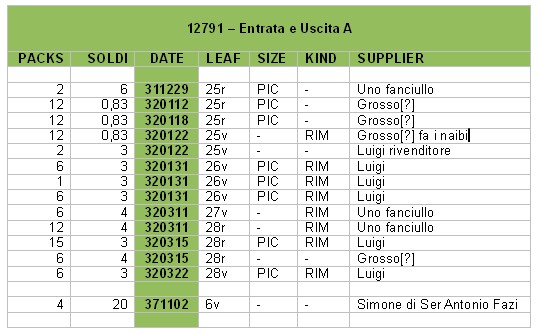
The corresponding dates are earlier than the limits indicated for the book and also earlier than most of the other records that I could study up to now - even the suppliers are not the same as we find later on. Luigi rivenditore certainly was not a cardmaker, but just a small retailer. Grosso[?] is thus the only maker recorded here; we have not yet encountered him elsewhere, and even his name, or nickname, is uncertain. Uno fanciullo, a boy, as a supplier of goods, is a rather frequent occurrence; unfortunately for us, any such indication does not help to trace the makers of the products.
The last entry corresponds to a purchase of four packs of naibi from Simone di Ser Antonio Fazi; his profession is not indicated, but we can assume him to be a cardmaker. It is unavoidable for us to connect him with Antonio di Simone, maybe his son, whom we find later on as a maker of expensive cards. Important is that we find here his family name too, and it has been possible to find him in Catasto 1427, the known series of books with much information on Florentine families.(8) I could read there that he was 33 and lived together with his wife, 25, and a third person; I was certain to find his child Antonio di Simone recorded together with his parents - unfortunately for us (and maybe for him) the third person of the family was instead by then... his mother-in-law.
|
3.5 Minor suppliers
a. Antonio Trinchaglia[?]
This is one of the many Florentine cardmakers, "che fa i naibi", with name Antonio. He may coincide with one or more of the other makers found here and there under the same name. The name of Trinchaglia, possibly a nickname, I could not read with certainty.
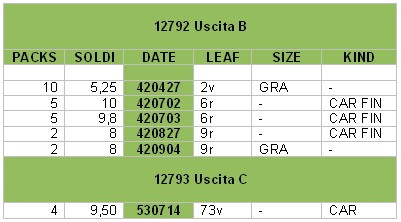
b. Meo di Ghoro
Meo di Ghoro che fa i naibi is a cardmaker that supplies naibi to the silk-dealers only for a few months of 1442. I could not find his products even in other stores that I have "visited" up to now. His prices were in the high range, comparable to those of Antonio di Simone, who was apparently preferred as a regular supplier – starting from about the same time.
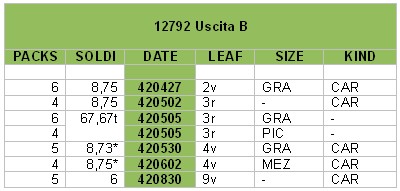
... [deleted passage]
d. Various suppliers
Sometimes we find cards from other suppliers, different from the "usual" cardmakers. Also a mercer (as typically Manetto d’Agnolo) could sometimes pay part of his debts with playing cards that he had acquired from elsewhere.
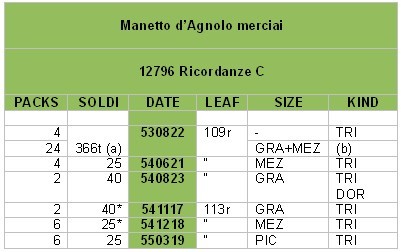
(a) The total recorded is L.18s.6. which would give 13s.* as average value for the three different packs. I could not find how to convincingly divide it into the three parts mentioned. Assuming 25s. for trionfi the average for grandi and mezzani would be too high at 11,08s*; more likely appear 40s., and 8,58s.*, respectively.
(b) these cards are indicated as by Paparello.
In a few cases, we find recorded "un dipintore", a painter, who evidently had some reason (or the silk-dealers had) not to record his name in the account books. In other cases, we find "un fanciullo", a boy, or "una donna" a woman; these are not exceptional entries in the books: on the contrary, it is a frequent occurrence that of "un viandante", a wayfarer, "un forestiero", a foreigner, "un amico", a friend, or similar attributes for suppliers, who are recorded in an anonymous way.
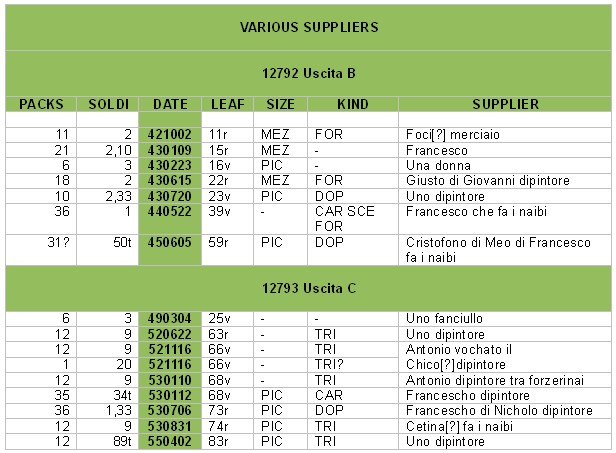 It is easy to suppose that any painter (or at least most of them) who supplies a dozen trionfi priced 9s. is the same person, even if recorded under different names.
It is easy to suppose that any painter (or at least most of them) who supplies a dozen trionfi priced 9s. is the same person, even if recorded under different names.
It may be worth noting that the fraction of trionfi in the cards acquired from these scattered suppliers of the early 1450s is greater than average. This may indicate that the "regular" suppliers of the store were not able to meet the demand of the silk-dealers for this particular product, but to be sure we should find some confirmation from other sources.
|
REPEATED TEXT: Abbreviations:
Franco Pratesi: "The abbreviations used should already be familiar to readers of the previous notes. As for size, they are GRA or grandi, large; MEZ mezzani, middle; MZL mezzanelli, the same as mezzani, or slightly different; PIC piccoli, small. As for kind, they are SCE or scempi, single; DOP doppi, double; DOR Dorati, gilded; CAR c(h)arte, cards; FIN fini, good quality; FOR di forma, made with woodblocks; RIM rimboccati, with folded edges; TRI trionfi. The abbreviation MIX, mixed, "di più ragioni", can involve both size and kind and clearly corresponds to the most uncertain values for the prices.
The date is in the format 14yymmdd. All the prices are reduced to soldi, (s.) changing into non-existent cents their fraction in denari (d.), one of which was 1/12 of 1s. (This explains the frequent appearance of N,67 or N,33 or similar approximate values.) An asterisk indicates that the price is an average value derived from the total amount recorded; it may be present for a single pack too, in case its price has been agreed upon.
There are several words that I am not sure to have read correctly and they are indicated as Name[?]."
Large text |
|
|
| SOURCE 5: Silk dealer sale lists
|
List of Playing Card Sales 1439 - 1454
(Silk trader Lorenzo di Bartolo and Matteo di Zanobi)
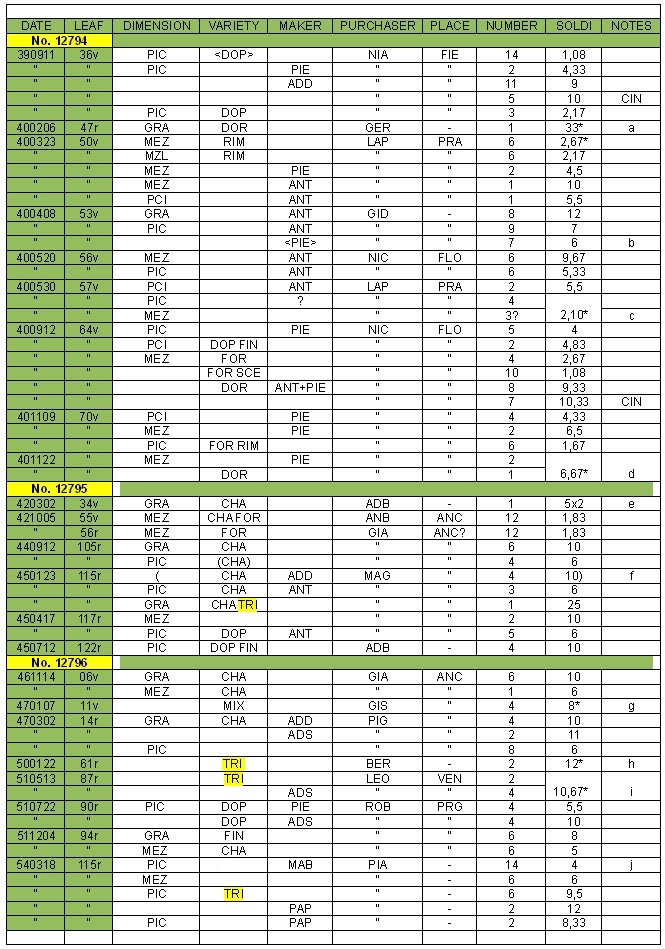
List of Abbreviations
(?) uncertain spelling of the previous word.
* price for single packs, deduced from the total price indicated as agreed upon.
<> the word inside can be read, but appears as deleted
ANC Ancona
ADB Antonio di Brunetto, see Purchasers
ADD Antonio di Dino, see Makers
ADS Antonio di Simone, see Makers
ANB Antonio di Beltramo, see Purchasers
ANT Antonio, see Makers
BER Bernardo, see Purchasers
CHA naibi recorded as charte
CIN Cinchaglie(?), see Makers
DOP doppi
DOR dorati, messi a oro
FIE fiera de la Vernia
FIN fini
FLO Florence
FOR a forma
GER Geradho di Paghole, see Purchasers
GIA Giannino d’Antonio, see Purchasers
GID Giovanni, see Purchasers
GIS Giannino di Simone, see Purchasers
GRA grandi
LAP Lapo, see Purchasers
LEO Leonardo, see Purchasers
MAB Matteo Ballerini, see Makers
MAG Martino di Giovanni, see Purchasers
MEZ mezzani
MIX more kinds together
MZL mezzanelli
NIA Nicholo di Nardo e Antonio di Iachopo merciai, see Purchasers
NIC Nicholao di Calvano, see Purchasers
PAP Paparello, see Makers
PCI piccini
PIA Pier Antonio di ser Barnaba, see Purchasers
PIC piccoli
PIE Piero, see Makers
PIG Piero di Giovanni, see Purchasers
PRA Prato
PRG Perugia
RIM rimboccati
ROB Ruberto di ser Bartolomeo, see Purchasers
SCE scempi
TRI trionfi
VEN Vinegia (Venice)
Notes and comments to the Tables
a - 1 pajo di najbi messi doro grandi per L.1s.13 dachordo.
b - 7 paia di najbi dj <pjero> piccjno per s.6 il paio.
c - 4 paja di najbj piccholi purghati(?) e 3 paja di najbj mezanj purghati(?) per s. quattordici d. otto tuttj.
d - In this case, the average price is for the 2+1 different packs.
e - The cost is twice the unitary price.
f - Apparently this entry has been corrected with the two following ones.
g - Charte di più ragioni, cards of several kinds, with total price agreed.
h - Trionfi da gugliare(?).
i - Dise per portare a Vinegia.
J - One reads 48s. a pair, but must be for a dozen.
Naibi purchasers
Particularly remarkable is the fact that the number and kind of purchasers of playing cards were only a small fraction of those recorded in the books. Most of them were colleagues silk-dealers. Cards can be found as acquired together with silk and other goods within rather long lists of goods that were purchased by a given merchant, often to be further sold far from Florence.
In the course of time, we encounter the following purchasers:
ADB Antonio di Brunetto e Brunetto suo figliuolo,
ANB Antonio di Beltramo,
BER Bernardo d’Uguccione Comp. merchatante,
GER Gerardo di Pagholo e comp. Setaiuoli,
GIA Giannino d’Antonio gharzone di Giano merciaio da Bergamo che usa per la Marca,
GID Giovanni di Datto(?) e comp. chorregiari,
GIS Giannino di Simone merciaio da Berghamo che usa per la Romagna,
LAP Lapo di Curino(?) speziale a Prato,
LEO Leonardo di Tomaso forzerinaio,
MAG Martino di Giovanni di Pellegrino da Bergamo merciai,
NIA Nicholo di Nardo e Antonio di Iachopo merciai,
NIC Nicholajo di Chalvano setaiolo in piazza dei Signori,
PIA Pier Antonio di ser Barnaba e comp. merciai,
PIG Piero di Giovanni di Pellegrino da Berghamo chiamato Barchetto merciaio sta a Ancona,
ROB Ruberto di ser Bartolomeo da Perugia e comp. mercatanti.
One family of purchasers is present more than once and may be taken as a useful example. This family comes from Bergamo and is often indicated with the name of the grandfather, Pellegrino, or maybe with a family name Pellegrini – in each case we find as purchaser one of his sons or grandchildren, or one of their boys, as Giannino d’Antonio.
At the time, Bergamo, as Milano and Brescia in the same area, was a typical supply of ironware, but these merchants had moved the center of their activity to Ancona. Moreover, they are indicated as active not only in that town, but in the whole Marche region; one of them (if he did not belong to another family from Bergamo) is indicated as active in Romagna. One of their purchases is particularly indicative: these goods were taken to be traded in a fair, fiera della Vernia(?).
Following the purchases of this family provides a more complete and correct view of the situation, with respect to what may be deduced simply from the Tables extracted from the book. As a matter of fact, we find many more purchases by this family than recorded in the Tables. This has two different reasons: the first is that sometimes they buy a more or less long list of items, without any card packs included. This is not too misleading for us¸ since we are just interested in their purchases of playing cards: if they come and buy nothing of this kind, it is exactly the same for us, as if they had not entered the shop at all.
There is however a second reason, which does not allow us to analyse these data in a statistically reliable way: sometimes, the list of the goods acquired is not reported at all. We find the date, the names, and the total amount of the purchase; it could even contain card packs, but we cannot deduce anything about their number, kind, and price. Something similar I had already indicated for Puri merciai, whose account book became more concise for the last months.(1) Something similar could have occurred for any seller and any purchaser: the account books were kept for balancing purchases and sales: it was essential to record the overall value of the goods, but not the single items traded.
Other purchasers come from different places. Ruberto or Roberto di ser Bartolomeo is a merchant from Perugia, Lapo from Prato. We have thus established that most naibi packs were purchased for a further trade, far from Florence. Possible explanations are that more suitable dealers existed in Florence for acquiring cards for local use, or even that any sale for local use was forbidden. (We have to remember that only in 1450 four card games, including trionfi, were allowed here.)
The presence of one purchaser is however enough to let the latter hypothesis become hardly tenable: Nicolao di Galvano is a fellow silk-dealer, active in the very centre of Florence. His location is stated as in front of Palazzo dei Signori, now Palazzo Vecchio. Moreover, in all the cases, in which the place of origin or activity of the purchaser is not indicated, it may be assumed to be Florence.
Cardmakers
Useful information we obtain on cardmakers. Some packs on sale in part were directly designated with the name of the maker. This was not the case for the cheapest cards, but it became increasingly the rule in correspondence to higher prices. This was not however an exclusive property of the most expensive packs sold for 10s. and more; also middle-priced packs at around a half of those prices can be found with the name of their maker. Evidently, these painters did not only produce costly packs on demand, but provided the sellers with some "standard" supply of their continuous production.
It is somewhat surprising that the number of makers that we find quoted in the course of about fifteen years is relatively small, as follows.
ANT Antonio,
ADD Antonio di Dino,
ADS Antonio di Simone,
MAB Matteo Ballerini,
PAP Paparello (Iacopo di Poggino di Luca),
PIE Piero Piccino,
It is possible that another maker is mentioned, CIN Cinchaglie(?). The problem here is that on the one hand I am not sure to have read correctly this name, possibly a nickname; on the other hand, it is also uncertain whether this name could instead be attributed to some quality of the cards.
Antonio, when quoted without family or father name, could be identical with one of the two following ones, or else with Antonio di Giovanni di Ser Francesco, or with Antonio di Luca, known from Catasto 1430 and 1427, respectively. Piero is sometimes present here (for ex. 12794, c.64v) with the nickname of Piccino and thus we cannot be sure whether we are in the presence of one or two Piero makers. Known from the literature is Piero di Donnino di Giovanni, and it is hard to say at present how many Piero were involved in the production of playing cards at the time.
Surprisingly, most of the makers recorded in these books were unknown to us. On the other hand, we find no trace of other renowned painters of naibi, such as Giovanni di ser Giovanni, or Filippo di Marco di Simone. The impression is that also for suppliers, as for purchasers, our silk-dealers had adopted some privileged channels for their trade.
|
|
| SOURCE 6: Lapini family records
|
Naibi sold in 1415-1422
The book in question is the first of the series, and in principle should cover the long time interval from 1415 to 1441. Unfortunately, its second part has been severely damaged and only the lower part of the pages can be read; moreover, the records themselves are there less detailed and complete. The handwriting is less fine than average, everywhere, but in the second half of the book it becomes hard to read. In conclusion, we should be satisfied, at least for the moment, with the few years for which I have been able to get the data of the following Table. As in other notes, the date is expressed as 14yymmdd and the price everywhere in soldi, with an approximation to hundredths of them, which did not correspond to any coin of the time (thus, for ex. s.8,67 should correctly be read as s.8d.8).
Abbreviations
DOZ Dozzinali
GRA Grandi
MEZ Mezzani
MZL mezzanelli
PIC Piccoli
VAN Vantag(g)iati
Notes to the Table
1. Cards indicated as made by Antonio.
2. Purchaser: Cristofano d’Agnolo, merciaio in Lucca.
3. Purchaser: Agnolo di Bartolomeo.
4. Purchaser: Andrea di Giovanni, forzerinaio.
5. Purchaser: Leonardo, merciaio.
6. Purchaser: Lorenzo d’Antonio, speziale a La Lastra.
7. Purchaser: Francesco, merciaio.
8. Purchaser: Andrea Stefani, merciaio in Lucca.
9. Purchaser: Tommaso di Francesco, merciaio.
10. Purchaser: Daddo d’Antonio, merciaio.
| 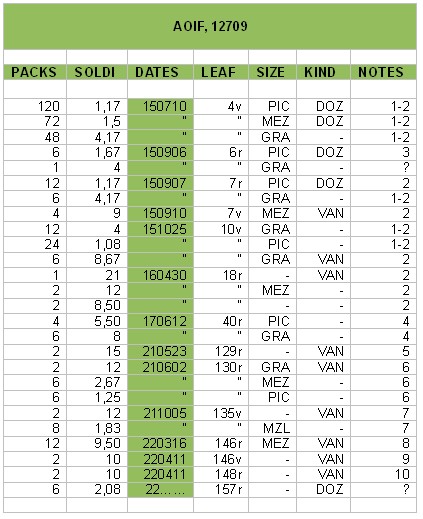 |
As mentioned before, the main reason of satisfaction is that these years are so early for playing card production that these new data become particularly interesting. This is evident just at the very beginning: thinking for July 1415 of a single purchase of no less than 240 Naibi packs, to be further sold in Lucca, is probably much more than anybody could have expected. Apparently, a local production was necessary to support a similar trade, and not of the kind of the single cardmaker who little by little produced one pack after another in the course of several months, as we were ready to expect.
I have already discussed the various attributes associated with naibi.(6) Dozzinali, sold by the dozen, is a clear sign of a rather low quality. Here we have both normal packs, needing no attribute, or provided with that of Dozzinali, and Vantaggiati, those of a better quality.
The corresponding costs should indicate if the better quality was on its turn a standard quality at a superior level, or instead the Vantaggiati attribute was used for several nuances of increasingly higher quality. For these cards, the indication is somewhat confounded by the presence of different sizes too, with different prices on their turn. However, the impression deriving from the various prices present here is that several degrees of better qualities were present.
As for makers, we find only one of them mentioned here: the entries with packs made by him are only about one fourth of the total; however, the proportion greatly increases, up to about three fourths, if the number of packs is taken into account. His name, Antonio, is the most frequent among Florentine cardmakers. However, in 1415, several of the cardmakers with the same name, whom we find in records of later times, were too young or even not yet born.
Unexpected is that we do not find this maker associated with the more expensive cards; on the contrary, he seems to have been able to provide this seller with great quantities of standard cards, to be sold at the lowest prices of the market.
No pack of the Vantaggiati quality is indicated with its maker’s name. It is apparent however that these were supplied by at least a second maker, and a confirmation we find below, when dealing with packs acquired.
The purchasers are also interesting. They are always indicated with name and profession, sometimes with their place of activity too. The profession is often the same or similar to that of the suppliers, Merciai, let us use the literally corresponding term of mercers. We could thus be in the presence of a trade from gross-dealer to retailer, but – at least for our Naibi – it seems rather to have been a trade among retailers.
When the place is not indicated, we can assume it to be Florence. La Lastra I prefer to associate to a small village close to Florence in the North direction, rather than Lastra a Signa, farther to the West. Lucca is easy to identify, even if I had no idea of any such predominance for the destination of these sales. Among the purchasers, this big town is even represented by two different mercers.§ In particular, we can verify that these purchases occurred at short intervals of time - this implies that these cards were quickly sold out in Lucca.
Of course, these data are not enough to deduce that in other towns, of dimensions similar to Lucca, some local production of cheap cards had been established already. I would only deduce that any such activity was not yet developed in Lucca, whichever its cause could have been.
The prices that we find recorded are also of great interest, because we (or let me better write I, to be sure) had no idea how expensive Naibi packs could be at the time. Surprisingly enough, what we find here indicates that the production was already established at a level comparable to that of one or two generations afterwards. The Vantaggiati packs apparently corresponded to the Fini packs of later years; this is not surprising – surprising may be that their prices were of the same order. Even more unexpected is that Naibi Dozzinali were already produced at such low prices, as we know for later times, when the total production seems to have greatly increased.
At the time, there was some inflation in the cost of living and the same nominal prices for 1415 and 1450 did not have the same real value. However, the difference can be dealt with as corresponding to a second approximation, and an increased precision in comparing prices can be delayed to a following study.
Naibi acquired in 1415-1418
Information on cards acquired by our mercers is more difficult to detect in the book, because the corresponding trade is of a different kind. Packs are typically sold directly by cardmakers, who used them for "paying” some goods previously acquired in the store. This "payment” occurred, as usual, in successive installments, which could be recorded in the course of several months, as follows.
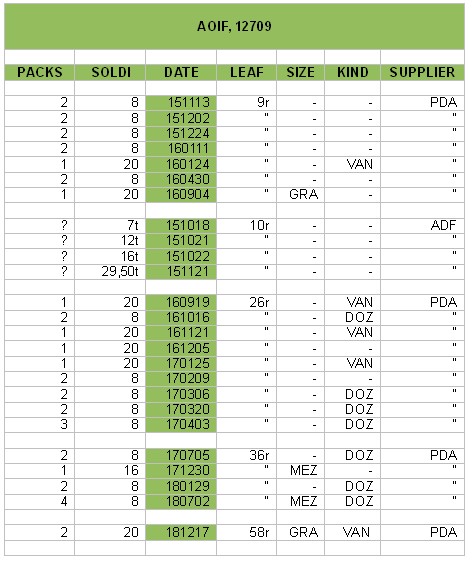
In the Table, a letter "t" after the soldi amount indicates that this is the total amount in soldi paid for an amount of packs that was not recorded. We are in the presence of two makers, Piero di Antonio (PDA) and Antonio di Francesco (ADF). The latter was likely the same indicated above as the maker of several packs sold in the store. We find only the record of the total price of his cards here, without any indication on unit prices. Piero di Antonio, on the other hand, appears as the supplier of the more expensive packs. Apart from one case of Naibi Mezzani recorded at 16s., all his packs were either Dozzinali, priced however as high as 8s., or Vantaggiati at 20. Apparently, he was not yet involved in any mass production, and the slow rate of his supplies may be a confirmation.
In other words, the two makers here encountered can be assumed as representative of two different ways of production: many packs of inferior quality or few high-class packs. Unfortunately, we do not have further data up to now, coming from any other cardmaker, already active in the town. We can however imagine that any additional maker, if already existing, could have employed one of the two mentioned kinds of production.
Naibi traded in 1453-1455
In the second book examined, we find a different and more familiar situation, corresponding to the middle of the 15th century. This is easier to compare with other account books already studied. However, there is something unusual in this book, which is thicker than similar ones, with more than three hundred leaves. It seems that the trade changed in the time of these records, with increasingly more entries concerning production rather than small trades of the shop. I have collected in the following Table all the packs that I could see in the book; namely, in its initial part.
* price for single packs, deduced from the total price and/or indicated as agreed upon.
Abbreviations
CAR Carte
DOP Doppi
GRA Grandi
MEZ Mezzani
PCI Piccini probably the same as Piccoli
TRI Trionfi
VAN Vantag(g)iati
Notes to the Table
1. Maker: Antonio di Dino.
2. Attribute added: begli, or fine.
3. Supplier: de la Lisa(?).
4. Purchaser: Agnolo d’Antonio, active in San Gimignano.
5. Supplier: Pagholo Corsellini, merciaio.
6. Attribute added: I could not read it.
| 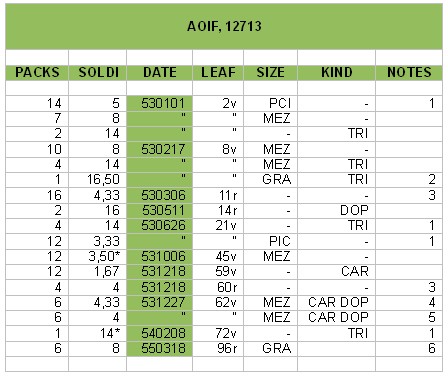 |
We can observe that low-quality packs still exist, but have rather become an exception among packs recorded here; only one dozen packs priced less than 2s. are present in the entries that I have seen in this store. Also at the other extreme we find a reduction of entries: the most expensive packs are a Naibi Doppi at 16s. and a Trionfi Grandi at 16s.6d. Other Naibi packs have prices in the middle range.
Interesting is also a case in which we see three Naibi packs acquired and sold on the same day, 27 December 1453: this immediately provides us with the information of the small mark-up adopted in this trade, less than 10%.
The appearance of Trionfi is remarkable; as it was easy to expect, they are priced higher than corresponding Naibi. However, we may note further details: apparently a price of 14s. had already become a standard price for them. These Trionfi seem generally to correspond to the Mezzani size, even though this is explicitly stated in just one occurrence; in the only one case in which we find the Grandi size indicated, the corresponding price only increases from 14s. to 16s.6d., still below that of several packs of Naibi Vantaggiati.
|
| SOURCE 7: Puri family records
|
Naibi "fini"
There is not only one kind of playing cards indicated under the common denomination of naibi: we find more different packs than we could expect. Let us first conclude our discussion of the "simple" playing cards with a last point worth noting. At the time, one could acquire different kinds of cards, at different prices. When I was a child, a few years later than one could actually visit this merciaio store in person, we had two kinds of local cards, of course Fiorentine grandi, but also Toscane piccole, with exactly the same figures appearing on the cards. I did not imagine that this difference in card dimension could have such a long tradition.
It would be too simple to have just to decide between small or large cards: we find more than two kinds of specimens; mezzani or middle are also on sale, if we move to packs of better quality. If we have enough money, in the middle of the 15th century, we can buy products sold at various prices; when they are indicated as "richi", or "fini", there is no doubt about their superior quality.
I have thus kept all the cards that were sold as single packs, instead of by dozen, separately listed. When introducing low and better quality, the problem of choosing the most suitable pack may become embarrassing - there could hardly be a limit toward the best qualities that one could look for. The variation in price for a given pack is thus very high, as it can be verified in the following Table: here you can select one pack that costs remarkably more than a whole dozen of the previous ones.
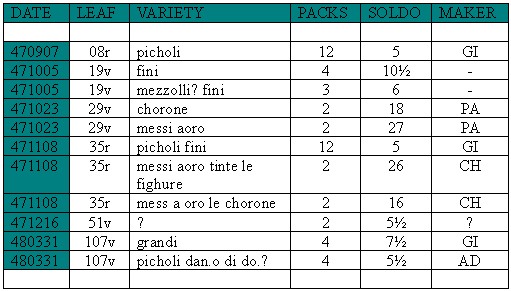
Several columns are the same as in the previous Table. The middle one here adds some indication on the pack in question. Then here we have the number of packs (instead of the dozens as in the previous Table) and their individual prices. In the last columns the makers are indicated, with GI for Giovanni di San Giovanni, PA for Paparello, and CH where chorone (crowns) are mentioned, see below.
It is worth noting that the time interval for these records is reduced to half a year, end 1447 - beginning 1448, remarkably shorter than for dozzinale packs of the first Table. Again, it is not clear if any reliable conclusion on card trade can be deduced from this, because there are further variables to consider, such as a shorter notation for the last entries.
We find here both picholi and grandi, but no mention of either scempi or doppi. This is a problem for understanding which were these packs from that point of view, but the ratio slightly less than two that would exist in corresponding prices is not so big, with respect to the higher ratios between these prices and those of "dozzinale" packs. A possibility is that Paparello-chorone packs at 16-18 s. were scempi, whereas those at 26-27 were doppi, but there is another plausible explanation for the more expensive packs, which not only had gilded crowns, but also carefully painted figures.
What seems to me particularly interesting is that you enter the store and have the choice among various kinds of packs, all of them ready to be sold. This is not so surprising for the cheap items, sold and bought by the dozen. There is however something else, also available onto the shelves, something of an increasingly better quality. Among the corresponding makers, we find names that can easily be compared with those renowned masters, who at the same time were producing their famous packs for the courts of Milan and Ferrara: Giovanni and Paparello were at least at their level. There is a big difference, however. Here, any merciaio can enter the store and acquire a pack made by one of the best painters, and without having to order it and waiting for weeks that it is finished.
Almost one half of these entries corresponding to costly packs are associated with Giovanni da San Giovanni as a painter. Apparently he provided the workshop with a large stock of packs ready to be sold, in a way that may be considered intermediate with respect to "dozzinale" packs. Indeed, we find in no less than two cases that his packs are sold in groups of twelve – nevertheless they are numbered and priced on the basis of single packs and not of dozens. Their price of 5 s. is intermediate between the packs of the first Table and the remaining ones, made with seemingly better quality and additional gold decoration.
One maker (an.o di do.o?) I have not been able to read. The painter who provides the most expensive packs is Paparello, whom we met in the list by Jacobsen(6). I read for some of these packs the word "oro" and the words "le chorone". In my opinion, the simplest interpretation is that the personages on these cards had their crowns directly gilded. In one case we find both chorone and Paparello in the description, and it seems possible that Paparello was the painter in all cases in which chorone are mentioned. In any case, the highest price corresponds to both gilded crowns and painted figures.
An extraordinary cardmaker
Several names of cardmakers and painters of playing cards who were active in Florence in about those years can be found here and there, but in Richordançe A we find one, who may be more interesting than all the remaining ones: Giovanni da San Giovanni. San Giovanni Valdarno is the present name of a country town that near the end of the 13th century had been built by the Florentines, with the name of Castel San Giovanni, as a fortified settlement in front of Arezzo (not to forget that San Giovanni Battista is still considered as the patron of Florence).
Our Giovanni painter was born there but, as it occurred for many artists, he lived and worked in Florence; this he did after having been active as a soldier in his youth. His outstanding plus point is not so much due to his personal value as a painter, however remarkable, but rather to that of his elder brother, nobody less than Masaccio. For Masaccio, let me add here just his dates of birth and death, 1401-1428 – he has been so great an artist that it is easy to get whatever information one may wish about him. His full name was Tommaso di ser Giovanni Guidi da San Giovanni; his younger brother was born in 1406, soon after the death of their father, so that he could take the same first name: Giovanni di ser Giovanni, then nicknamed Lo Scheggia.(7)
I could read no less than three whole books dedicated to him, (8,9,10) where I could not find (yet) any trace of playing cards. It may be worth noting however that, while he is not known as a painter of triumphal cards, he is renowned for some of the triumphal processions that he painted on cassoni, the big and finely decorated trunks that were part of the marriage settlements of the brides.
Art historians should be warned not to expect that the revolutionary style of Masaccio could be passed to his brother as a painter of playing cards. Here no revolutionary improvement in style is welcome: the aim of the work is just to satisfy the conservative attitude of the players, who always prefer, and by far, that their traditional images are changed the least as possible.
I feel the last practical point is not taken sufficiently into account by art historians, when they pay some attention to playing cards, en passant. It is therefore a pleasure for me to provide them with the documented name of a painter, whom they already know from different productions. Even if art historians have written little or no pages about him as a card painter, I feel certain that they will soon find their remedy to this, with new hundreds of pages. There is an additional advantage: I give them exact dates for these cards, but thanks to the long life of this artist, it will be unlikely for them, in this case, to attribute to a painter cards produced before his birth or after his death.
|
| SOURCE 8: Bartholomeo Seragli commissions
|
One old article with ancient documents
I could read the article quoted myself and use it for further study. You can probably imagine my surprise in finding that all the new information precisely derives from the account books kept in the Archivio Storico dell’Ospedale degl’Innocenti, which I had began to study a few weeks ago. (I might add that the only Cambini’s Quaderno that I leafed through had been No. 266, whereas this new information derives from the Nos. 264, 265, 267, and 268. However, it is likely that even if I had instead examined one of these four volumes, my conclusion would have been the same.)
I will now continue the discussion with the help of the information that can be directly derived from the article mentioned above. The article is structured in a first part compiled by Hartt with discussion and comments and in a second part written by Corti with a selection of documents taken from the account books. In the following paragraph, I copy the part of the selection of documents inserted in the original article that is of interest for us. I have labelled A to G these quotations, but have kept in brackets the numbers that they have in the article.
|
A [3]. Estranei 264, c. 226, left side
Bartolommeo di Paholo Seragli de’ dare...
E adì 10 di marzo [1452/53] f. otto, per lui a Pipo di Marcho portò contanti, sono per uno paio di trionfi richi ebe da lui. f. 8.
B [5] Estranei 264, c. 241, left side
Bartolomeo di Pagholo Seragli de’ dare...
E adì 21 di marzo f. uno largo, per lui a Filipo di Marcho dipintore, portò contanti, sono per parte di lavoro gli à fato. f.1 s.4.
C [6]. Estranei 265, c. 27, left side
Bartolomeo di Pagholo Serragli de’ dare…
E adì 31 di marzo [1453] f. 5 larghi, per lui a Filippo di Marcho dipintore, portò e’ detto contanti, sono per resto di 2 paia di trio[n]fi fatogli, come dise Ghaspare da Ghiaceto. f. 5 s. 18 d. 4.
D [13]. Estranei 267, c. 35, left side
1455
Bartolomeo di Pagholo Seragli de’ dare…
E adì 29 di marzo f. quatro, portò e’ detto, sono per paghare a Filipo di Marcho, per 3 paia di trionfi e 2 paia di charte. f. 4
E [15]. Estranei 267, c. 98, left side
1455
Bartolomeo di Pagholo Seragli de’ dare…
E adì 6 di settembre f. due, per lui a Pipo dipintore, portò Giovanni di Domenicho contanti, per trionfi. f. 2.
….
E adì 20 detto f. uno, per lui a Pipo dipintore, portò Giovanni di Domenicho contanti, per trionfi. f. 1.
…
E adì 27 detto f. dua larghi, per lui a Pipo di Marcho dipintore, portò Giovanni di Domenicho contanti. f.2 s.6 d.7.
E adì 10 d’otobre f. uno largho, per lui a Filipo di Marcho dipintore, portò contanti, per un paio di trionfi operati. f.2 s.6 d.7.
….
E adì 21 detto, L. trenta, per lui a Filipo di Marcho dipintore, portò contanti: sono per resto di trionfi auti da lui insino a questo dì. f. 7 s.- d.8.
F [17] Estranei 267, c. 206
Bartolomeo di Pagolo Seragli de’ dare…
E adì 17 detto [April 1456] L. sedici piccioli, per lui a Filippo di Marcho dipintore, portò chontanti, e quali dise gli prestava per trionfi gli deve fare. f.3 s.20 d.6.
…
E adì 30 detto f. quatro larghi, per lui a Filippo di Marcho dipintore, portò contanti, dise per parte di trionfi gl’àne a fare. f.4 s.26 d.7.
…
E adì 15 detto [May] L. dieci, per lui a Filippo di Marcho dipintore, portò contanti, dise èrono per trionfi che da lui. f.2 s.9 d.8.
G [22]. Estranei 268, c. 217, left side
1457
Bartolomeo di Pagholo Seragli de’ dare…
E adì 17 detto [April 1, 1458] L. quatordici s. X piccioli, per lui a Filippo di Marcho dipintore, portò contanti, sono per 2 paia di trionfi. f. 3 s.10 d.6.
|
First of all, we have to understand the function of Bartolomeo Serragli in this trade, and for this we can directly use the "explanation" provided in the article.
|
The most striking patron to emerge from this group of documents is the little-known Bartolommeo di Paolo Serragli, who commissions in rapid succession from 1455 through 1457 (Documents 3-22) a fantastic amount of sculpture from Desiderio da Settignano, Andrea della Robbia, and Donatello himself, and paintings from Filippo di Marco and Filippo Lippi, all to the tune of about three hundred florins (including Donatello’s materials but not the final price for the statue), a handsome sum for a family that had just survived ten years of exclusion from public offices and seven years of exile imposed by Cosimo de’ Medici. ... Corti’s new discoveries provide the solution: Bartolommeo Serragli was an art dealer, one of the earliest of whom we have any such exhaustive record. |
This dealer was particularly active towards the South of Italy, down to Naples and its royal palace. Some comments can be added now. Interesting enough is that these particular cards were of various qualities and values. Together with rather cheap items, we find pricey ones: remarkable among them is the first pack encountered, in 1453. One could simply conclude that at this rather early time it was still a new and costly kind of production, but also the contrary opinion can easily be supported: the very fact that this pack was indicated as unusually rich may prove that more current ones existed already.
|
Oddly enough, the only project to vie with the Donatello statue in expense in this entire series of entries is the so-far completely baffling set of "trionfi" for which Filippo di Marco is paid very nearly fifty florins at intervals from March 10, 1452/3 to April 1, 1458 (Documents 3, 5, 6, 13, 15, 17, 22). At this moment Filippo di Marco is a personality of the utmost obscurity. We know nothing of him beyond his matriculation in the Arte dei Medici e Speziali in 1447 (Thieme-Becker, "Allgemeines Lexicon…", XI, 1915, p. 564.) and none of the triumphs can be identified with any certainty; for the moment I will not try. From the documents it is not even possible to count them, although one cannot help noting that they generally seem to turn up in pairs. [This author clearly did not know the denotation of paio as a card pack. FP] There may have been as many as eight of these pairs, one pair is listed as "richi" (Document 3) and another as "operati" (Document 15). The phrases suggest scene-painting or designs for masques or parades rather than pictures, but in the absence of any evidence speculation had best stop at that point. Perhaps they were paintings after all, and if they can same day be identified among the various homeless Quattrocento panels representing such subjects, we will be the richer by one more minor master.
|
Rather astounding may be the fact that just in one case can "simple" playing cards be found as manufactured and acquired. We had rather expected the contrary situation, in which ordinary cards were the rule and triumphs the exception. Apparently, triumphs were precisely the kind of playing cards most looked for, at the time, in this particular kind of trade.
Somewhat surprising is also the fact that all these different packs were produced by one and the same cardmaker, Filippo di Marco. We can imagine him as a kind of "Florentine Sagramoro", but evident dissimilarities appear, to begin with the actual customers, not a Duke of the Este family, but just an art dealer, who could sell further these cards practically anywhere.
|
My note: The text notes Filippo di Marco, also addressed as "Pipo". Additionally appears at three places Giovanni di Domenicho, who should be identical to Giovanni Domenico, who delivered Trionfi cards to the silk dealers in 1449-1453. In the later article
http://trionfi.com/cardmakers-woodblock-trial
Repeated Note:
When Ross Caldwell and me in 2003 started to collect Trionfi notes between 1442-1463, we had about 27/28 entries (which I nowadays would count as 31). The major part were the documents of Ferrara, which were collected by Gherardo Ortalli and Adriano Franceschini in the "Prince and the Playing Cards" (1996), after the base laying works of Michael Dummett and Stuart Kaplan around 1980. This collection included 2 notes about Trionfi cards in Florence, found by Franco Pratesi in his earlier work (allowances of the Trionfi game in 1450 and 1463). A graphical representation of this time (with 27 entries) shows the dominance of Ferrarese documents (in black) with a few notes only from other locations (in red; see picture to the right)
In the period 2004 till October 2011 it was possible to add 4 further notes (Siena 1452, Padova 1455, Ancona c. 1460 and Valerio Marcello c. 1460), mainly thanks to information given by Thierry Depaulis.
Franco Pratesi started his new article series in November 2011. Since then the list has gotten 67 new documents till September 2012 (65 of them found by Franco Pratesi, one, now the oldest of September 1440, by Thierry Depaulis, and another one by Veber Gulinelli, who controlled the earlier work of Franceschini and found an overlooked document) and nearly all are related to Florence or its surrounding.
A small book (118 pages) was published around Christmas 2012, Franco Pratesi: "Playing Card Trade in 15th Century Florence" as IPCS Paper No. 7 (ISSN 0305-2133). It contains some of the articles, which before had appeared at this website, those, which treat the early time of 15th century. Thierry Depaulis commented in his foreword: "This book is a landmark in the history of early playing cards in Italy".
Well, maybe not the book, but the research is clearly a landmark in various interests. For the collection of early Trionfi notes it somehow means, that we have within the year 2012 about 200 % more data for the period 1440-1462 than mankind had collected in the 200 years before.
Added later:
In August 2013 the new report of Arnold und Doris Esch: "Aus der Frühgeschichte der Spielkarte. Der Import von carte da giocare und trionfi nach Rom." in Gutenberg Jahrbuch 2013, 88. Jahrgang, p. 41-53, arrived in our redaction. It contains 106 new references to Trionfi decks, which all were found in the customs registers of the city Rome for the period 1453-1465. With this the number of all earlier Trionfi cards records has been doubled and should have reached then c. 210 (from which a few are only considered to be "Trionfi card notes" and don't contain the word "Trionfi" or something similar).
***********
I'd started to sort the new Trionfi card documents overview in October 2012. Articles will be possibly changed according improvements in research.
|
Old Overview about Trionfi Card documents in 2003

Overview about Trionfi Card documents in 2013
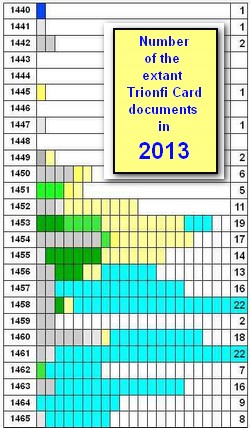 READ MORE
READ MORE
|
|













